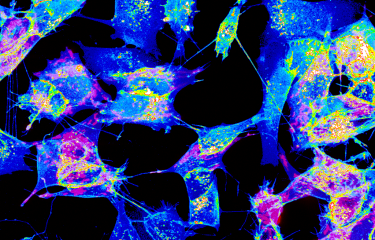One major line of research on the process of carcinogenesis lies in understanding the mechanisms underpinning the establishment of polarity. The Membrane Traffic and Cell Division Laboratory, directed at the Institut Pasteur by Arnaud Echard (Institut Pasteur/CNRS UMR 3691), is looking into apical-basal polarity acquisition mechanisms during cell division when organs are being formed. The team has discovered the crucial role of a GTPase-type enzyme known as Rab35.
Epithelia are layers of cells that cover the surface of our bodies and internal organs. They form a genuine barrier and perform various other functions. These roles are possible since epithelial cells are non-symmetrical and organized into two opposite poles. To use the proper terminology, they are organized with an apical pole and basolateral pole ('apical-basal' polarity). These poles constitute distinct, specialized domains that enable the transport of compounds from the cell interior to the external environment and vice versa. Most tumors originate in the epithelial tissue and loss of polarity is a common occurrence in tumor progression. Therefore, one major line of research on the process of carcinogenesis lies in understanding the mechanisms underpinning the establishment of polarity.
The Membrane Traffic and Cell Division Laboratory, directed at the Institut Pasteur by Arnaud Echard (Institut Pasteur/CNRS UMR 3691), is looking into apical-basal polarity acquisition mechanisms during cell division when organs are being formed. As part of this research, the team has recently discovered the crucial role of a GTPase-type enzyme known as Rab35. Using a 3D in vitro polarity model, scientists have demonstrated full polarity inversion in renal cells deprived of Rab35, whereby the apical domain switches places with the basolateral domain. They also discovered that the location of the apical domain is dependent on a direct link between Rab35 and another apical protein, Podocalyxin, which is already known to control polarity and is involved in tumor progression.
This work therefore describes a new mechanism enabling normal polarity to be established. By revealing the role of Rab35 in polarity, they have demonstrated how this GTPase could be involved in the tumor process, explaining the oncogenic effect of Rab35 mutations recently detected in some patients.

Photo : spheroid of renal cells cultivated in vitro. The cells' apical pole is shown in green and their nuclei in red. In blue are the primary cilia ("antennae") leaving the cells via their apical poles.
Source
Rab35 GTPase couples cell division with initiation of epithelial apico-basal polarity and lumen opening, Nature Communications, April 4, 2016
Kerstin Klinkert (1,2,3), Murielle Rocancourt (1,2), Anne Houdusse (4) & Arnaud Echard (1,2)
(1) Membrane Traffic and Cell Division Lab, Cell Biology and Infection Department, Institut Pasteur, 25–28 rue du Dr Roux, 75724 Paris, France.
(2) Centre National de la Recherche Scientifique UMR3691, 75015 Paris, France.
(3) Sorbonne Universités, Université Pierre et Marie Curie, Université Paris 06, Institut de formation doctorale, 75252 Paris, France.
(4) Institut Curie, Structural Motility Lab, 26 rue d’Ulm, 75005 Paris, France.
Mis à jour le 04/04/2016









